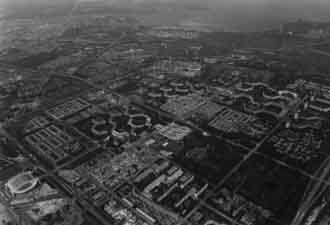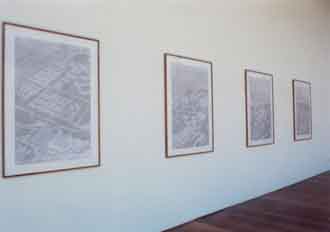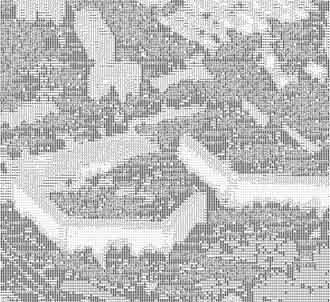| 3 |
Talk in the series 'Producing the Future: Art and Globalization' organized by the Center for Place, Culture (April 24 2003) Sabine Bitter / Helmut Weber |
<< >> |
||
          |
image.source As we said before – one of our interests are architectural urban sites which held social promises at a certain time. The late modernist social housing projects are examples for that. But what strikes us most is that the photographic representation of these sites serve as argument for new programs or neoliberal politics. To negotiate this shortening of image and indexicality we developed a series of works which we call Image.source A first realisation we did in 2000 is based on an arial view of a famous social housing project in amsterdam, called the Bijmermer from the 60ies / 70ies, which stands now almost as a symbol for the failure of not only social housing policies but even for the welfare state. we used the photographs to ask a question on the constituing Elements of this specific architecture - and its representation. ----- the foto was transferred into an ascii image with random textcharacters - then we had a perl script written which let us replace the randow text with a specific text- well one which you can read, makes sense. ----- our intention was, to use the discussion on urbanity and city developments to construct the image - and at the same time - to read it into the image. With this process city-photography becames a cultural text - social and cultural realtions become readable or become articulated. Technically is the process: from photographic grain to pixel to textcharacters. through the text/image image/text we provide an access and points of entries, which are not so obvious/maybe hidden/obscured within a discourse on architecture and city. Insofar the text has at the same time a visual and a semantic function. ----- The chosen texts refer in various ways to the housing project Bijmer, ranging from a text by Walter Gropius, CIAM Konferenz 1929, Die soziologischen Grundlagen der Minimalwohnung, or Rem Koolhaas, the Generic City, or Mike Davis - The Mercenaries, Epilogue: Gramsci vs Blade Runner - aus City of Quartz oder Saskia Sassen: Die neue Zentralität - Auswirkungen von Telematik und Globalisierung In each of the 4 images there are about 20 pages of Text embedded - or the other way around: each 20 pages of Text construct each a slightly different view onto the housing project. When we used a program originally from the web for making the image source prints – We were thinking of how to transfer it back to the web, when we got invited for a webproject. It was actually following the logics when we put these 4 huge textimages as real text on the web. Therefor it was depending how you had your fontsize in the brwoser set – but in any case you could not see the whole image on one screen. When you scrolled along over the textimage, the cursor was followed by this small original fotograph which was the basis for textimage. the 4 different text-htmls were linked through same terms appearing in all texts . Another image source we made about the peripherie of vienna which we combined with a text by max weber, a vienna sociologist, who now people look back to. This medialisation is probably as far as you can can get away of photography with digtalizing, running through one program, running through another script, print as text - but at the same time question the photographic process and use. But also the image source photoseries work best when using aireal photographs as a basis. The modernist overview, the scopic regime is in itself another interesting issue. Eclectic Atlases.... |
|||